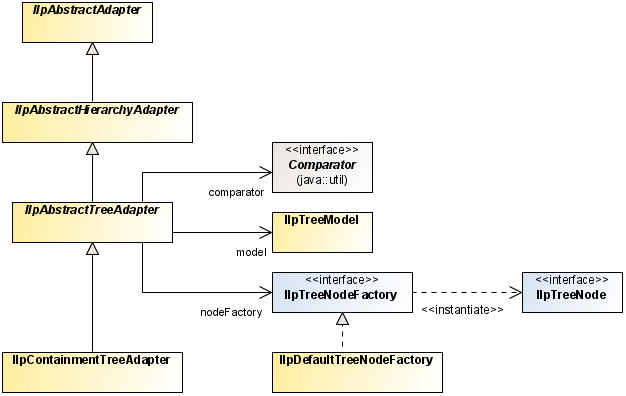The tree adapter converts business objects retrieved from the
associated data source to tree nodes. It is defined by the class IlpContainmentTreeAdapter.
The tree adapter retrieves structural
information (that is parent/child relationship) about business
objects from the associated data source and determines whether an
object should appear as a root representation object.
The default tree adapter implementation
provides the following services:
- Filtering the tree nodes. For details, see Filtering the tree nodes
- Sorting the tree nodes. For details, see Sorting the tree nodes
- Controlling the display of objects as tree leaves. For details, see Controlling the display of objects as tree leaves
- Setting a list of origins. For details, see Setting a list of origins.
- Creating the tree nodes. For details, see Representation object factory.
- Loading the tree nodes on demand. For details, see Expansion strategy.
The following figure shows the tree adapter
classes.

Containment tree adapter classes
You can create a containment tree adapter implicitly by
instantiating the
IlpTree
component as shown in the following example.
How to create a tree adapter by instantiating a tree component
IlpTree ilpTree = new IlpTree(); IlpDataSource dataSoure = new IlpDefaultDataSource(); ilpTree.setDataSource(dataSource);
How to retrieve a tree adapter
IlpAbstractTreeAdaper adapter = ilpTree.getAdapter();
Representation object factory
The tree adapter converts business objects retrieved from the
associated data source to tree nodes. The new representation
objects are created by a representation object factory. The
factory interface varies according to the type of adapter. The
containment tree adapter uses by default an IlpDefaultTreeNodeFactory that creates
representation objects of type IlpDefaultTreeNode.
Expansion strategy
The tree adapter uses an expansion
strategy to identify whether objects should be loaded or not in
the tree model. An expansion strategy defines how an object is
going to behave when an expansion is requested, for example, when
the user opens a tree node by double-clicking or using the tree
expansion handles. The expansion strategy indicates whether load
on demand is implemented and provides methods to load and release
child nodes.
The tree adapter uses an expansion strategy factory to define the
expansion strategy for each tree node that it creates. The
default expansion strategy factory implementation ( IlpDefaultTreeExpansionStrategyFactory)
verifies the property
"expansion"
defined for each business object in the cascading style sheet
loaded in the component.
The default tree expansion strategy
factory supports three types of expansion strategies:
IN_PLACE: loads the child objects on demand, as the user expands the parent tree node. In this expansion strategy, tree nodes are considered as parent nodes, only when they have containment relationships defined in the attached data source, through the IlpContainer interface. The child objects should already be loaded in the data source, and should be visible according to the data source filter, if there is one defined.IN_PLACE_MINIMAL_LOADING: loads the child objects on demand, as the user expands the parent tree node. All tree nodes with this expansion strategy are considered as possible parent nodes, and therefore are represented with an expansion icon. If the tree node does not contain child objects, the expansion icon will disappear when the expansion is executed for the first time.NO_EXPANSION: expansion is not supported by the tree node.
For information on how to customize the business object expansion
type, see Customizing the expansion of business
objects .
The expansion strategy factory can be customized for the adapter
either through CSS or through the API. See Configuring the tree component.
Editing
Adapter interfaces are read-only, meaning
that they do not perform editing operations on the representation
objects they create.